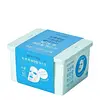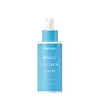What's inside
What's inside
 Key Ingredients
Key Ingredients

 Benefits
Benefits

 Concerns
Concerns

 Ingredients Side-by-side
Ingredients Side-by-side

Water
Skin ConditioningGlycerin
HumectantMethylpropanediol
SolventButylene Glycol
Humectant1,2-Hexanediol
Skin ConditioningSodium Hyaluronate
HumectantSodium Acetylated Hyaluronate
HumectantHydrolyzed Hyaluronic Acid
HumectantLactobacillus/Soybean Ferment Extract
Skin ConditioningLactobacillus/Rice Ferment Filtrate
Skin ConditioningLactobacillus
Skin ConditioningSaccharomyces/Coix Lacryma-Jobi Ma-Yuen Seed Ferment Filtrate
Skin ConditioningSaccharomyces/Potato Extract Ferment Filtrate
HumectantGlycine
BufferingSerine
MaskingGlutamic Acid
HumectantAspartic Acid
MaskingLeucine
Skin ConditioningAlanine
MaskingLysine
Skin ConditioningTyrosine
MaskingPhenylalanine
MaskingThreonine
Proline
Skin ConditioningValine
MaskingIsoleucine
Skin ConditioningHistidine
HumectantMethionine
Skin ConditioningCysteine
AntioxidantTremella Fuciformis Polysaccharide
Emulsion StabilisingPyrus Communis Fruit Extract
Skin ConditioningRosa Damascena Flower Water
MaskingCucumis Melo Fruit Extract
Skin ConditioningVetiveria Zizanoides Root Oil
MaskingHedera Helix Leaf/Stem Extract
AntimicrobialOlea Europaea Fruit Oil
MaskingButyrospermum Parkii Butter
Skin ConditioningHydrogenated Lecithin
EmulsifyingSqualane
EmollientCholesterol
EmollientCeramide NP
Skin ConditioningPhytosphingosine
Skin ConditioningAcetyl Glucosamine
Skin ConditioningSodium Polygamma-Glutamate
Emulsion StabilisingMusa Sapientum Fruit Extract
Skin ConditioningCaprylic/Capric Triglyceride
MaskingPropanediol
SolventFructan
Skin ConditioningAllantoin
Skin ConditioningTrehalose
HumectantArginine
MaskingDextrin
AbsorbentHydroxypropyl Methylcellulose
Emulsion StabilisingCI 77220
Cosmetic ColorantGlycolic Acid
BufferingHydroxyacetophenone
AntioxidantTocopheryl Acetate
AntioxidantCarbomer
Emulsion StabilisingXanthan Gum
EmulsifyingPolyglyceryl-10 Laurate
Skin ConditioningCitric Acid
BufferingSodium Citrate
BufferingDisodium EDTA
Water, Glycerin, Methylpropanediol, Butylene Glycol, 1,2-Hexanediol, Sodium Hyaluronate, Sodium Acetylated Hyaluronate, Hydrolyzed Hyaluronic Acid, Lactobacillus/Soybean Ferment Extract, Lactobacillus/Rice Ferment Filtrate, Lactobacillus, Saccharomyces/Coix Lacryma-Jobi Ma-Yuen Seed Ferment Filtrate, Saccharomyces/Potato Extract Ferment Filtrate, Glycine, Serine, Glutamic Acid, Aspartic Acid, Leucine, Alanine, Lysine, Tyrosine, Phenylalanine, Threonine, Proline, Valine, Isoleucine, Histidine, Methionine, Cysteine, Tremella Fuciformis Polysaccharide, Pyrus Communis Fruit Extract, Rosa Damascena Flower Water, Cucumis Melo Fruit Extract, Vetiveria Zizanoides Root Oil, Hedera Helix Leaf/Stem Extract, Olea Europaea Fruit Oil, Butyrospermum Parkii Butter, Hydrogenated Lecithin, Squalane, Cholesterol, Ceramide NP, Phytosphingosine, Acetyl Glucosamine, Sodium Polygamma-Glutamate, Musa Sapientum Fruit Extract, Caprylic/Capric Triglyceride, Propanediol, Fructan, Allantoin, Trehalose, Arginine, Dextrin, Hydroxypropyl Methylcellulose, CI 77220, Glycolic Acid, Hydroxyacetophenone, Tocopheryl Acetate, Carbomer, Xanthan Gum, Polyglyceryl-10 Laurate, Citric Acid, Sodium Citrate, Disodium EDTA
Sea Water
HumectantDipropylene Glycol
HumectantButylene Glycol
Humectant1,2-Hexanediol
Skin ConditioningGlycerin
HumectantGlycereth-26
HumectantWater
Skin ConditioningAcrylates/C10-30 Alkyl Acrylate Crosspolymer
Emulsion StabilisingTromethamine
BufferingCaprylic/Capric Triglyceride
MaskingHydrolyzed Sodium Hyaluronate
Skin ConditioningAdenosine
Skin ConditioningHydrogenated Lecithin
EmulsifyingDisodium EDTA
Azadirachta Indica Leaf Extract
Skin ConditioningPanthenol
Skin ConditioningPopulus Tremula Flower Extract
Skin ConditioningCetearyl Alcohol
EmollientPropanediol
SolventActinidia Chinensis Fruit Extract
EmollientStearic Acid
CleansingSolanum Melongena Fruit Extract
Skin ConditioningAloe Barbadensis Leaf Extract
EmollientGlycine Soja Seed Extract
Skin ConditioningOcimum Sanctum Leaf Extract
Skin ConditioningCeramide NP
Skin ConditioningCurcuma Longa Root Extract
MaskingCoral Extract
Skin ConditioningPolyglutamic Acid
Skin ConditioningPolyglyceryl-10 Myristate
Skin ConditioningHydrolyzed Pea Protein
EmollientPhytosterols
Skin ConditioningLecithin
EmollientSqualane
EmollientOlea Europaea Fruit Oil
MaskingButyrospermum Parkii Butter
Skin ConditioningPalmitoyl Pentapeptide-4
Skin ConditioningAcetyl Hexapeptide-8
HumectantCopper Tripeptide-1
Skin ConditioningOzone
Sea Water, Dipropylene Glycol, Butylene Glycol, 1,2-Hexanediol, Glycerin, Glycereth-26, Water, Acrylates/C10-30 Alkyl Acrylate Crosspolymer, Tromethamine, Caprylic/Capric Triglyceride, Hydrolyzed Sodium Hyaluronate, Adenosine, Hydrogenated Lecithin, Disodium EDTA, Azadirachta Indica Leaf Extract, Panthenol, Populus Tremula Flower Extract, Cetearyl Alcohol, Propanediol, Actinidia Chinensis Fruit Extract, Stearic Acid, Solanum Melongena Fruit Extract, Aloe Barbadensis Leaf Extract, Glycine Soja Seed Extract, Ocimum Sanctum Leaf Extract, Ceramide NP, Curcuma Longa Root Extract, Coral Extract, Polyglutamic Acid, Polyglyceryl-10 Myristate, Hydrolyzed Pea Protein, Phytosterols, Lecithin, Squalane, Olea Europaea Fruit Oil, Butyrospermum Parkii Butter, Palmitoyl Pentapeptide-4, Acetyl Hexapeptide-8, Copper Tripeptide-1, Ozone
Ingredients Explained
These ingredients are found in both products.
Ingredients higher up in an ingredient list are typically present in a larger amount.
1,2-Hexanediol is a synthetic liquid and another multi-functional powerhouse.
It is a:
- Humectant, drawing moisture into the skin
- Emollient, helping to soften skin
- Solvent, dispersing and stabilizing formulas
- Preservative booster, enhancing the antimicrobial activity of other preservatives
Butylene Glycol (or BG) is used within cosmetic products for a few different reasons:
Overall, Butylene Glycol is a safe and well-rounded ingredient that works well with other ingredients.
Though this ingredient works well with most skin types, some people with sensitive skin may experience a reaction such as allergic rashes, closed comedones, or itchiness.
Learn more about Butylene GlycolThis ingredient is also known as shea butter. It is an effective skin hydrator and emollient.
Emollients help soothe and soften your skin. It does this by creating a protective film on your skin. This barrier helps trap moisture and keeps your skin hydrated. Emollients may be effective at treating dry or itchy skin.
Shea butter is rich in antioxidants. Antioxidants help fight free-radicals, or molecules that may harm the body. It is also full of fatty acids including stearic acid and linoleic acid. These acids help replenish the skin and keep skin moisturized.
While Shea Butter has an SPF rating of about 3-4, it is not a sunscreen replacement.
Shea butter may not be fungal acne safe. We recommend speaking with a professional if you have any concerns.
Learn more about Butyrospermum Parkii ButterThis ingredient is an emollient, solvent, and texture enhancer. It is considered a skin-softener by helping the skin prevent moisture loss.
It helps thicken a product's formula and makes it easier to spread by dissolving clumping compounds.
Caprylic Triglyceride is made by combining glycerin with coconut oil, forming a clear liquid.
While there is an assumption Caprylic Triglyceride can clog pores due to it being derived from coconut oil, there is no research supporting this.
Learn more about Caprylic/Capric TriglycerideCeramide NP is a type of ceramide and formally known as ceramide 3.
Ceramides are intercellular lipids naturally found in our skin that bonds dead skin cells together to create a barrier. They are known for their ability to hold water and thus are a great ingredient for dry skin.
Ceramides are an important building block for our skin barrier. A stronger barrier helps the skin look more firm and hydrated. By bolstering the skin ceramides act as a barrier against irritating ingredients. This can help with inflammation as well.
If you would like to eat ceramides, sweet potatoes contain a small amount.
Read more about other common types of ceramides here:
Ceramide AP
Ceramide EOP
Disodium EDTA plays a role in making products more stable by aiding other preservatives.
It is a chelating agent, meaning it neutralizes metal ions that may be found in a product.
Disodium EDTA is a salt of edetic acid and is found to be safe in cosmetic ingredients.
Learn more about Disodium EDTAGlycerin is already naturally found in your skin. It helps moisturize and protect your skin.
A study from 2016 found glycerin to be more effective as a humectant than AHAs and hyaluronic acid.
As a humectant, it helps the skin stay hydrated by pulling moisture to your skin. The low molecular weight of glycerin allows it to pull moisture into the deeper layers of your skin.
Hydrated skin improves your skin barrier; Your skin barrier helps protect against irritants and bacteria.
Glycerin has also been found to have antimicrobial and antiviral properties. Due to these properties, glycerin is often used in wound and burn treatments.
In cosmetics, glycerin is usually derived from plants such as soybean or palm. However, it can also be sourced from animals, such as tallow or animal fat.
This ingredient is organic, colorless, odorless, and non-toxic.
Glycerin is the name for this ingredient in American English. British English uses Glycerol/Glycerine.
Learn more about GlycerinHydrogenated Lecithin is created from the hydrogenation of lecithin (a group of phospholipids). Hydrogenation is a chemical reaction between hydrogen and another element.
This ingredient is an emollient and emulsifier. As an emollient, it helps soften skin by trapping moisture within. As an emulsifier, it prevents oil and water ingredients from separating.
Olea Europaea Fruit Oil is the fixed oil obtained from the ripe fruit of the Olive. In other words - olive oil.
The primary contents of olive oil are glycerides of the fatty acids linoleic, oleic and palmitic.
Olive oil also contains antioxidants such as Vitamin E. Antioxidants may help reduce signs of aging by fighting unstable free-radical molecules. It also contains Vitamins A (retinol), D, and K.
The squalene in olive oil makes it a great emollient. Emollients help soothe and soften your skin by trapping moisture in. This makes olive oil a great skin moisturizer.
Studies show olive oil to have antibacterial and antifungal properties in low concentrations. Another study found olive oil irritated sensitive oily skin. We always recommend speaking with a professional about using this ingredient in your routine.
Due to the fatty acid content, this ingredient may not be fungal-acne safe.
Learn more about Olea Europaea Fruit OilPropanediol is an all-star ingredient. It softens, hydrates, and smooths the skin.
It’s often used to:
Propanediol is not likely to cause sensitivity and considered safe to use. It is derived from corn or petroleum with a clear color and no scent.
Learn more about PropanediolSqualane is an emollient that helps the skin hold onto moisture. It's an oily liquid that occurs naturally in certain types of fish and plant oils.
Because squalane boosts hydration in the skin, it also comes with plenty of benefits: it is an antioxidant and can help fight free radicals and skin damage. Squalane is also found to have a detoxifying effect when applied.
Squalane comes from squalene, which occurs naturally within the sebum of our skin. It is one of the oils our skin produces to keep itself hydrated. Squalane is the hydrogenated version of squalene and has a longer shelf life.
Research shows that squalane is non-irritating (even at 100% concentration).
In general, it's a fantastic ingredient. It does a great job at hydrating the skin, and it's suitable for those with sensitive skin.
The source of squalane may impact malassezia / fungal acne. This is because olive oil derived squalane can contain impurities such as fatty acids and plant waxes. Sugarcane derived squalane is recommended for anyone with malassezia concerns.
Is squalane vegan?
This depends on the source. Squalane can be derived from both plants and animals. Most squalane used in skincare comes from plants.
Please note: the source of squalane is only known if disclosed by the brand. We recommend reaching out to the brand if you have any questions about their squalane.
Read more about squalene with an "e".
Is squalane an oil?
Squalane is often called an oil, but it’s technically not; it’s a hydrocarbon, meaning it’s only made of carbon and hydrogen, unlike true oils which are triglycerides made of fatty acids and glycerol.
The term “oil-free” isn’t regulated, so companies can define it however they want. Some exclude all oils, while others just avoid mineral oil or comedogenic oils.
While some people avoid oils thinking they cause breakouts, the right kind of oil (or oil-like ingredient like squalane) can actually help balance and hydrate your skin. It’s worth testing out simple oils or squalane to see what works best for your skin.
Learn more about SqualaneWater. It's the most common cosmetic ingredient of all. You'll usually see it at the top of ingredient lists, meaning that it makes up the largest part of the product.
So why is it so popular? Water most often acts as a solvent - this means that it helps dissolve other ingredients into the formulation.
You'll also recognize water as that liquid we all need to stay alive. If you see this, drink a glass of water. Stay hydrated!
Learn more about Water